2019 MERCEDES-BENZ CLA COUPE weight
[x] Cancel search: weightPage 241 of 330
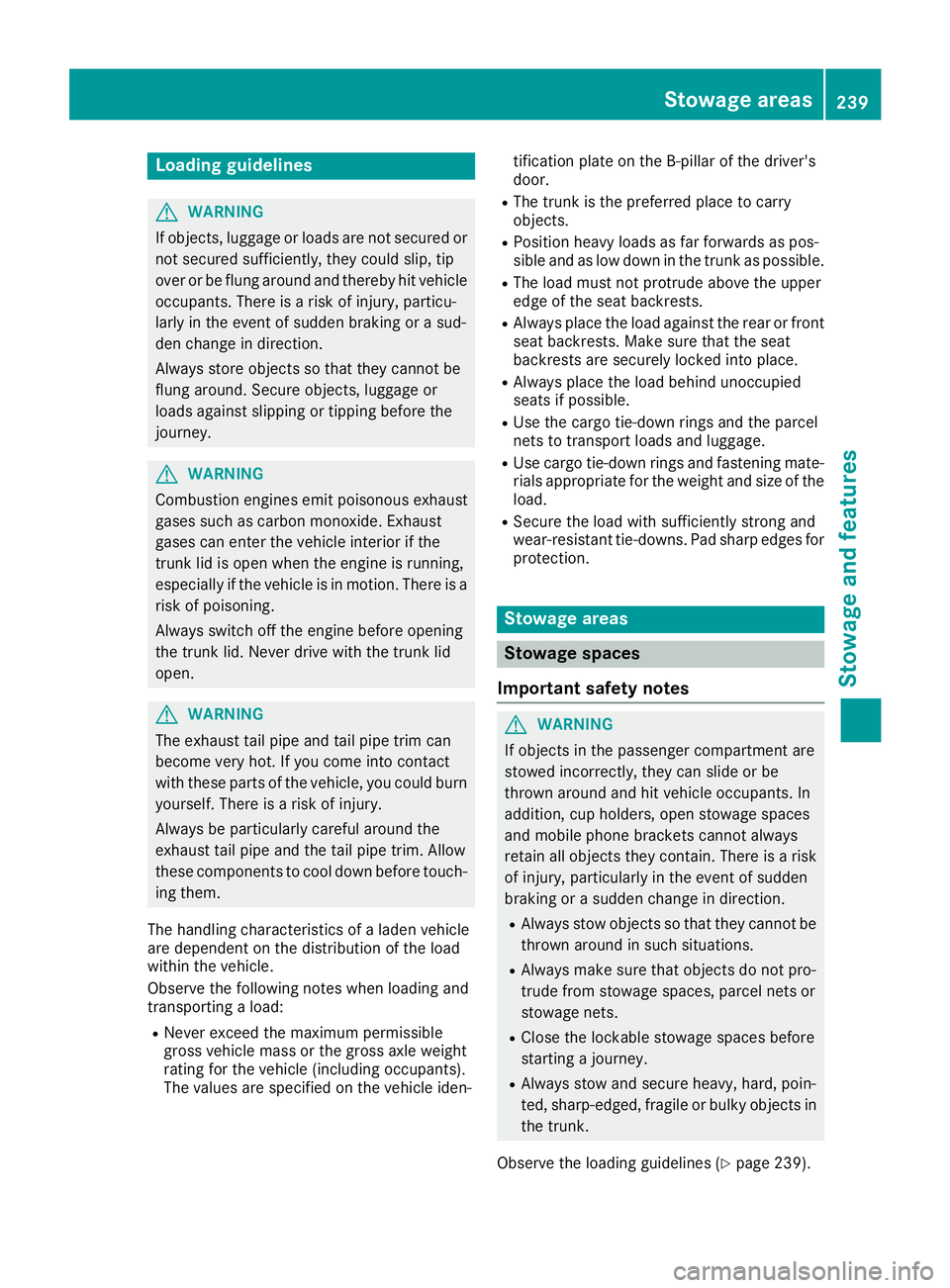
Load
ingguid elines G
WAR
NING
If obj ect s,luggage orloads arenot secured or
not secured sufficiently, they could slip,tip
over orbe flun garoun dand thereb yhit veh icle
occ upant s.Ther eis arisk ofinjury, particu-
larly intheeven tof sudden brakingorasud-
den chan geindirec tion.
Always store object sso that they can not be
flun garoun d.Sec ure object s,luggage or
loads againstslippin gor tipping beforethe
jo urn ey. G
WAR
NING
Combus tioneng inesemit poiso nous exhaust
gases suchascar bon mon oxide. Exhaust
gases canentertheveh icle interio rif th e
tr unk lidisopen when theeng ineisrun ning,
espec iallyifth eveh icle isin mot ion.Ther eis a
risk ofpoiso ning.
Always switchoff theeng inebefo reopen ing
th etrunk lid.Nev erdriv ewith thetrunk lid
open . G
WAR
NING
The exhaust tailpipe andtailpipe trim can
bec ome veryhot .If you com eint ocon tact
with these part sof theveh icle,you could burn
yourse lf.Ther eis arisk ofinjury.
Always bepart icular lycar eful aroun dth e
exh aust tailpipe andthetail pipe trim. Allo w
th ese com ponentsto coo ldown beforetouch-
ing them.
The handlingchar acteris ticsof aladen vehicle
are depen denton thedist ribut ionoftheload
with intheveh icle.
Obse rvethefollo wing noteswhen loadin gand
tr ans port ingaload:
R Nev erexc eed themax imum permissible
gro ssveh icle mass orthegro ssaxle weight
rat ing fortheveh icle (includin gocc upant s).
The values arespec ified ontheveh icle iden - tif
icat ion plat eon theB- pillar ofthedriv er's
door .
R The trunk isthepref erred place tocar ry
obj ect s.
R Posit ionheavy loadsasfar forwards aspos-
sible andaslow down inthetrunk asposs ible.
R The load must notprot rude above theupper
edge oftheseat backrests.
R Always placetheload again sttherear orfro nt
seat backrests.Mak esure that theseat
back restsare securely lockedintoplace .
R Always placetheload behin dunoc cupie d
seat sif poss ible.
R Use thecar gotie-do wn rings and theparc el
net sto trans port loads andluggage .
R Use cargotie-do wn rings and fasteningmat e-
rials appro priatefor theweight andsizeof the
load.
R Sec ure theload withsufficiently stron gand
wear- resistant tie-do wns .Pad shar pedges for
prot ection. St
owage areas St
owage spaces
Imp ortant safety notes G
WAR
NING
If obj ect sin thepasse ngercom partmen tare
st owed incorrect ly,they can slide orbe
th rown aroun dand hitveh icle occupant s.In
addit ion,cup holde rs,open stowage spaces
and mobi lephon ebrac ketscan not always
ret ain allobj ect sth ey con tain .Ther eis arisk
of injury, particular lyin theeven tof sudden
brak ingorasudden changeindirec tion.
R Always stow object sso that they can not be
th rown aroun din such situatio ns.
R Always makesure that obj ect sdo not pro-
tr ude fromstowage spaces,parc elnet sor
st owage nets.
R Close theloc kable stowage spacesbefo re
st art ing ajo urn ey.
R Always stow and secure heavy, hard,poin-
ted ,shar p-edged, fragileorbulky object sin
th etrunk .
Obse rvetheloadin gguidelin es(Y page 239). St
owage areas
239Stowage andfeatures Z
Page 248 of 330
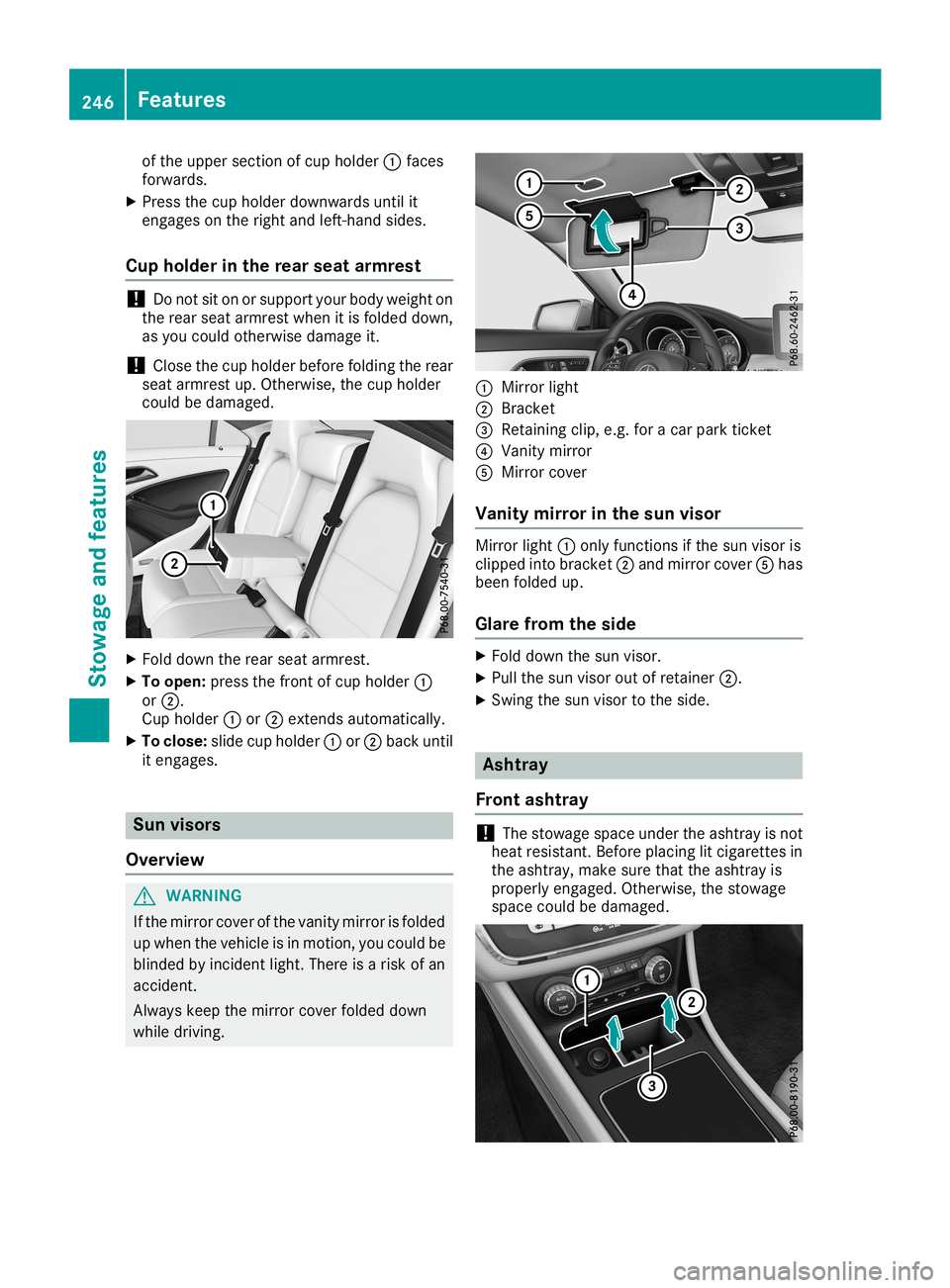
of
the upper section ofcup holder 0043faces
forwards.
X Press thecup holder downwards untilit
engages onthe right andleft-h andsides.
Cup holder inthe rear seat armrest !
Do
not siton orsupport yourbody weight on
the rear seat armrest whenitis folded down,
as you could otherwise damageit.
! Close
thecup holder before folding therear
seat armrest up.Otherwise, thecup holder
could bedamaged. X
Fold down therear seat armrest.
X To open: pressthefront ofcup holder 0043
or 0044.
Cup holder 0043or0044 exten dsautomatically.
X To close: slidecupholder 0043or0044 back until
it engages. Sun
visors
Overview G
WARNING
If the mirror coverofthe vanity mirror isfolded
up when thevehicle isin motion, youcould be
blinded byincident light.There isarisk ofan
accident .
Always keepthemirror coverfolded down
while driving. 0043
Mirror light
0044 Brack et
0087 Retaining clip,e.g.foracar park ticket
0085 Vanity mirror
0083 Mirror cover
Vanit ymirr orinthe sun visor Mirror
light0043only funct ionsifthe sun visor is
clipped intobracket 0044and mirror cover0083has
been folded up.
Glare fromtheside X
Fold down thesun visor.
X Pull thesun visor outofretainer 0044.
X Swing thesun visor tothe side. Ashtra
y
Front ashtray !
The
stowage spaceundertheashtray isnot
heat resistant .Before placing litcigarett esin
the ashtray, makesurethattheashtray is
properly engaged. Otherwise, thestowage
space couldbedamaged. 246
Featur
esStowage andfeatu res
Page 286 of 330
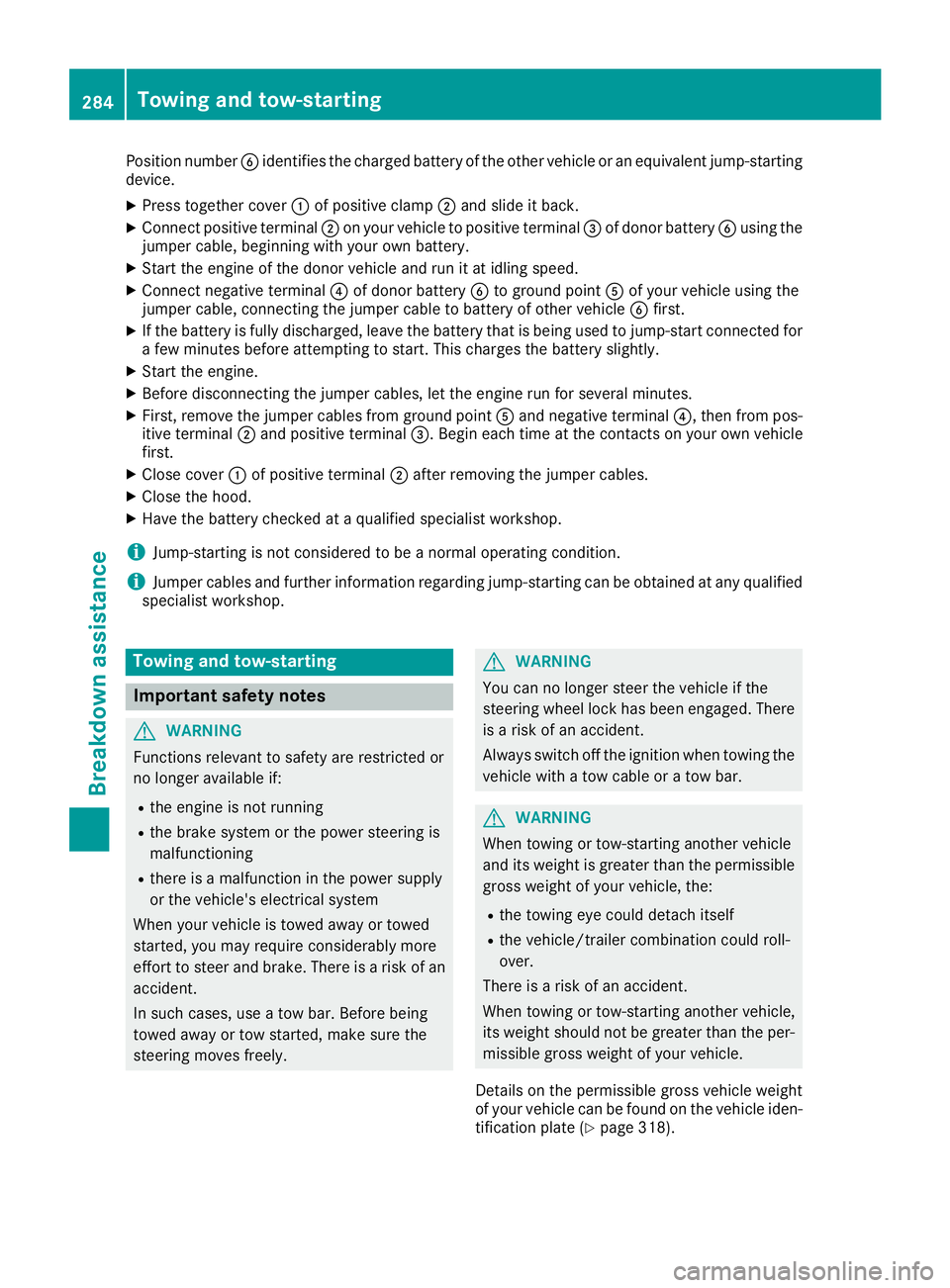
Position
number0084identifies thecharged batteryofthe other vehicle oran equivalent jump-starting
device.
X Press togethercover 0043ofpositive clamp0044and slide itback.
X Connec tpositive terminal0044 onyour vehicle topositive terminal0087 ofdonor battery 0084using the
jumper cable,beginnin gwith your ownbattery.
X Start theengine ofthe donor vehicle andrunitat idling speed.
X Connec tnegative terminal0085 ofdonor battery 0084toground point0083ofyour vehicle usingthe
jumper cable,connectin gthe jumper cabletobattery ofother vehicle 0084first.
X Ifthe battery isfully discharged, leavethebattery thatisbeing usedtojump-st artconn ected for
a few minutes beforeattemptingtostart .This charges thebattery slightly.
X Start theengine.
X Before disconn ectingthe jumper cables,letthe engine runforseveral minutes.
X First ,remove thejumper cablesfromground point0083and negative terminal0085, then from pos-
itive termin al0044 and positive terminal0087. Begin eachtimeatthe cont acts onyour ownvehicle
first.
X Close cover0043ofpositive terminal0044 after removin gthe jumper cables.
X Close thehood.
X Have thebattery checkedataqualified specialist workshop.
i Jump-start
ingisnot cons idered tobe anormal operating condition.
i Jumper
cablesandfurther informationregarding jump-startingcanbeobtained atany qualified
specialist workshop. Towing
andtow-sta rting Impor
tantsafety notes G
WARNIN
G
Funct ionsrelevant tosafety arerestr icted or
no longer availabl eif:
R the engine isnot runnin g
R the brake system orthe power steerin gis
malfunct ioning
R there isamalfunct ioninthe power supply
or the vehicle's electricalsystem
When yourvehicle istowed awayortowed
start ed,you may require considerably more
effort tosteer andbrake. Thereisarisk ofan
accident .
In such cases, useatow bar. Before being
towed awayortow start ed,make surethe
steerin gmoves freely. G
WARNIN
G
You cannolonger steerthevehicle ifthe
steerin gwheel lockhasbeen engaged. There
is arisk ofan accident .
Always switchoffthe ignition whentowing the
vehicle withatow cable oratow bar. G
WARNIN
G
When towing ortow-st arting another vehicle
and itsweight isgreater thanthepermissible
gross weight ofyour vehicle, the:
R the towing eyecould detach itself
R the vehicle/t railercombinat ioncould roll-
over.
There isarisk ofan accident .
When towing ortow-st arting another vehicle,
its weight should notbegreater thantheper-
missible grossweight ofyour vehicle.
Det ails onthe permissible grossvehicle weight
of your vehicle canbefound onthe vehicle iden-
tificat ionplate (Ypage 318). 284
Towing
andtow-sta rtingBr eakdown assistance
Page 303 of 330
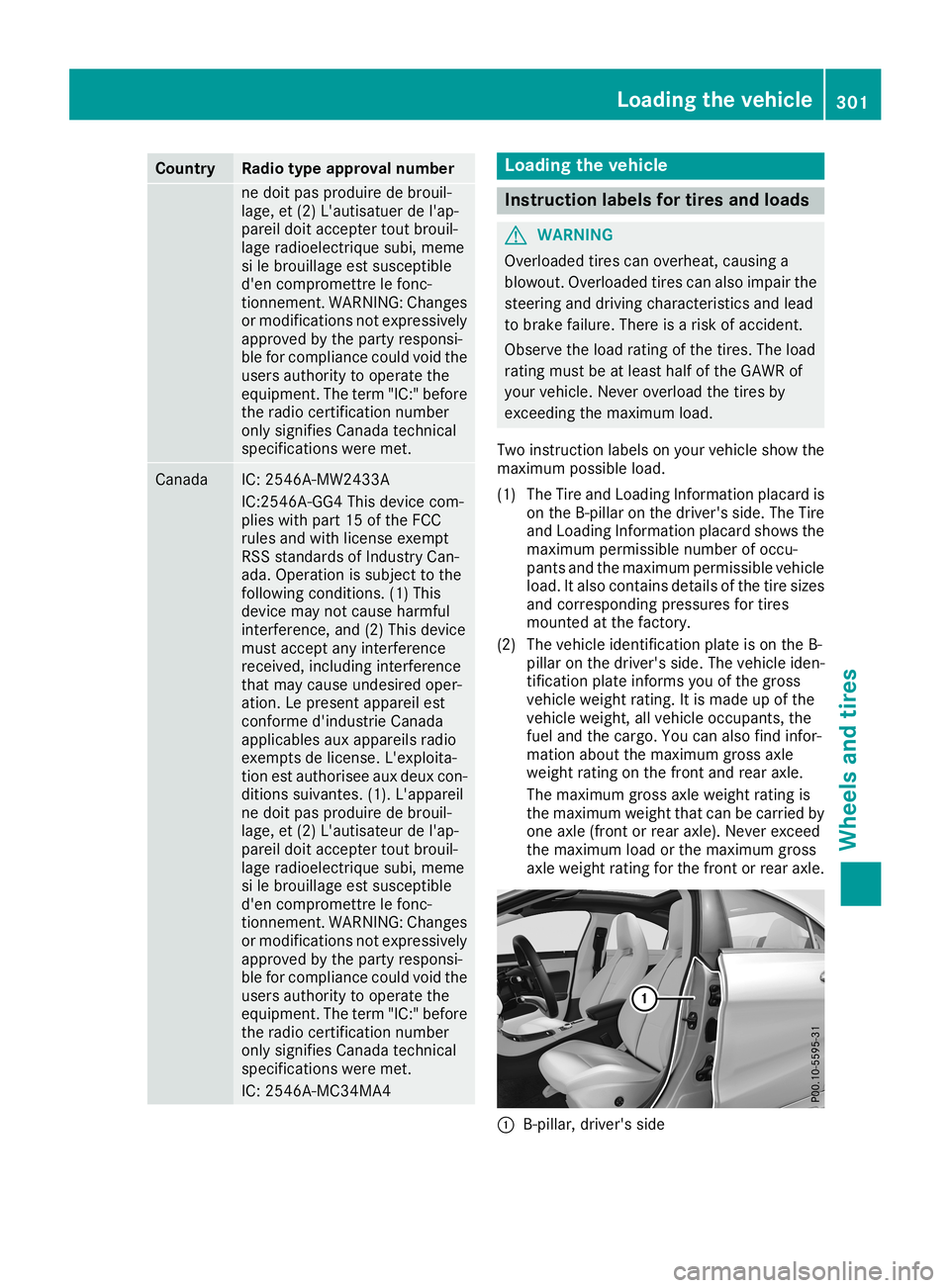
Count
ry Ra
dio type approval number ne
doit pasprod uiredebrouil -
lage, et(2) L'aut isatuer del'ap-
pareil doitacceptertout brouil -
lage radioe lectrique subi,meme
si le brouil lageestsusc eptible
d'en comprom ettrelefon c-
tio nnemen t.WARN ING:Chang es
or modi ficatio nsnot expressive ly
appro vedbythepart yres pon si-
ble forcom plian cecould voidthe
users authorityto oper atethe
equipm ent.The term"IC: "befo re
th eradio certificat ion num ber
onl ysign ifies Canada technical
spec ificatio nswere met. Canada IC:
2546A-MW2 433A
IC: 2546A-GG4 Thisdevic ecom -
plies withpart15oftheFCC
rules andwith licenseexe mpt
RSS standar dsofIndust ryCan-
ada. Oper ationis subj ecttothe
follo wing condition s.(1) This
devic emay notcause harmful
int erf eren ce,and (2)This devic e
must accept any interf eren ce
rec eived ,inc ludin gint erf eren ce
th at may cause undesiredoper -
atio n.Le pres entappare ilest
con forme d'indust rieCanada
applic ablesauxappare ilsradio
exe mpt sde lice nse. L'ex ploit a-
tio nest auth oriseeaux deux con-
dit ion ssuivan tes.(1). L'app areil
ne doit pasprod uiredebrouil -
lage, et(2) L'aut isateur del'ap-
pareil doitacceptertout brouil -
lage radioe lectrique subi,meme
si le brouil lageestsusc eptible
d'en comprom ettrelefon c-
tio nnemen t.WARN ING:Chang es
or modi ficatio nsnot expressive ly
appro vedbythepart yres pon si-
ble forcom plian cecould voidthe
users authorityto oper atethe
equipm ent.The term"IC: "befo re
th eradio certificat ion num ber
onl ysign ifies Canada technical
spec ificatio nswere met.
IC: 2546A-MC34 MA4 Load
ingthevehicle Inst
ruction labels fortires and loads G
WAR
NING
Ove rloade dtir es can over heat ,causi nga
blowout .Ove rloade dtir es can also impair the
st eerin gand drivingchar acteris ticsand lead
to brak efailur e.Ther eis arisk ofacc iden t.
Obse rvetheload rating ofthetir es. The load
rat ing must beatleast halfoftheGAWR of
your vehicle.Nev erover load thetir es by
exc eedin gth emax imum load.
Two instruct ion labels onyour vehicle show the
max imum possibleload.
(1) TheTire andLoadin gIn for mat ionplacar dis
on theB- pillar onthedriv er'sside. TheTire
and Loadin gIn for mat ionplacar dshows the
max imum permissiblenum berofocc u-
pant sand themax imum permissibleveh icle
load. Italso contain sdet ails ofthetir esiz es
and correspon ding pressures fortires
moun tedatthefac tory.
(2) Thevehicle iden tificat ion plat eis on theB-
pillar onthedriv er'sside. Thevehicle iden -
tif icat ion plat einf orm syou ofthegro ss
veh icle weight rating .It is made upofthe
veh icle weight ,all veh icle occupant s,the
fuel andthecar go. You canalso findinf or-
mat ionabout themax imum grossaxle
weight rating onthefro ntand rear axle.
The maximum grossaxle weight rating is
th emax imum weight that can becar ried by
one axle (front orrear axle) .Nev erexc eed
th emax imum loadorthemax imum gross
axle weight rating forthefro ntor rear axle. 0043
B-pillar ,driv er'sside Load
ingthevehicle
301Wheels andtires Z
Page 304 of 330
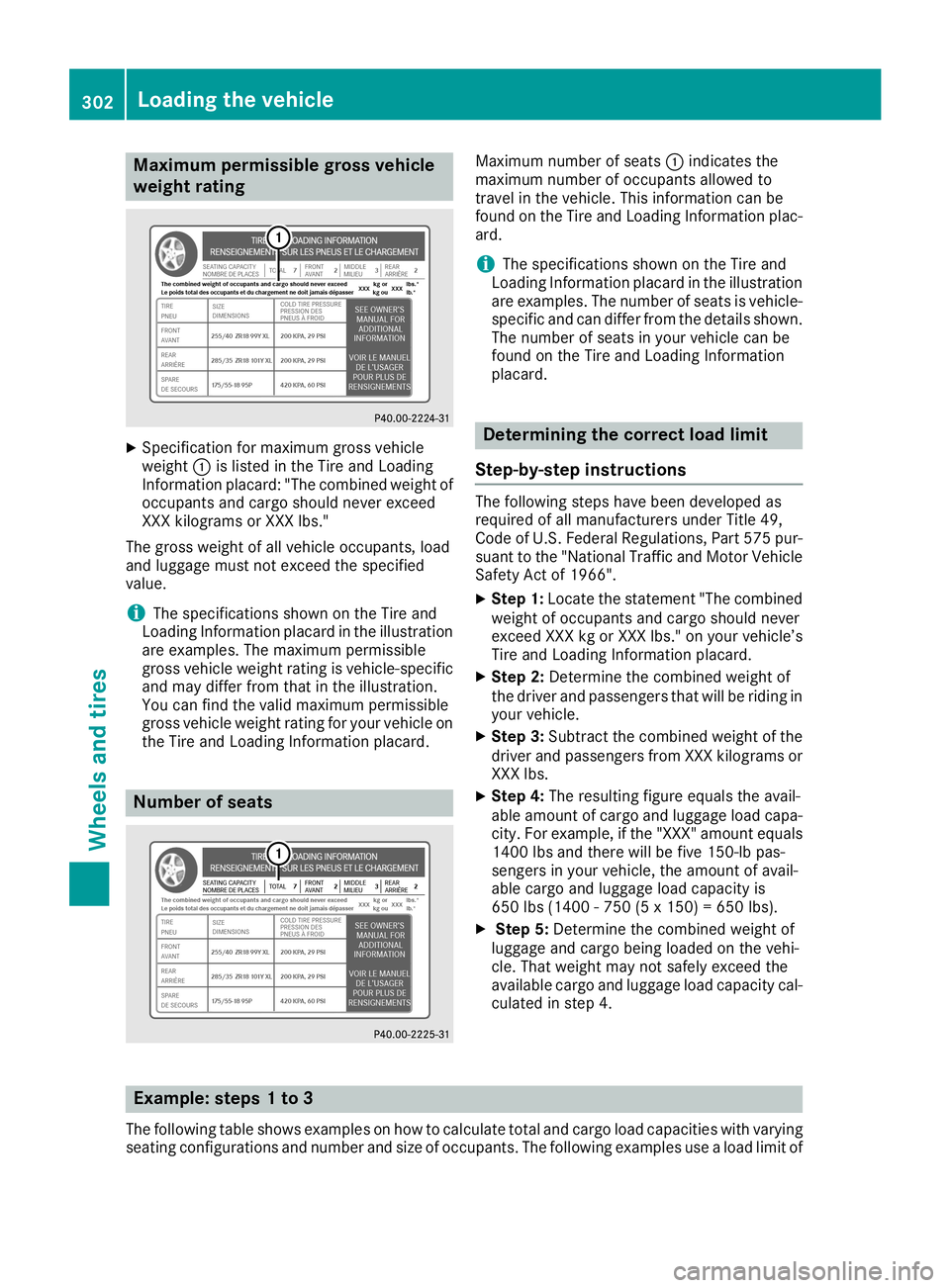
Maximum
permissiblegross vehicle
we ight rating X
Specifi cation formaximu mgross vehicle
wei ght 0043islisted inthe Tire andLoad ing
Informatio npla card: "Thecombined weight of
occupa ntsand cargo shouldnever exceed
XXX kilog rams orXXX lbs."
The gross weight ofall vehicl eoccupa nts,load
and luggage must notexceed thespeci fied
valu e.
i The
speci ficatio nsshow non the Tire and
Load ingInformatio npla card inthe illustrati on
are exampl es.The maximu mpermi ssible
gross vehiclewei ght rating isvehicl e-speci fic
and may differfrom thatinthe illustrati on.
You canfind thevalidmaximu mpermi ssible
gross vehiclewei ght rating foryou rvehicl eon
the Tire andLoad ingInformatio npla card. Number
ofseats Maximu
mnumber ofseats 0043indica testhe
maximu mnumber ofoccupa ntsallowe dto
travel inthe vehicl e.This informa tioncanbe
found onthe Tire andLoad ingInformatio npla c-
ard.
i The
speci ficatio nsshow non the Tire and
Load ingInformatio npla card inthe illustrati on
are exampl es.The number ofseats isvehicl e-
speci ficand candiffe rfrom thedetai lsshow n.
The number ofseats inyou rvehicl ecan be
found onthe Tire andLoad ingInformatio n
pla card. De
terminin gthe correct loadlimit
Step-by-ste pins tructions The
followi ngsteps havebeen developed as
requ iredofall manufa cturers underTitle49,
Cod eof U.S. Federa lReg ulations, Part575pur-
sua ntto the "National Trafficand Motor Vehicle
Safety Actof1966".
X Step 1:Locate thestatement "Thecombined
wei ght ofoccupa ntsand cargo shouldnever
exceed XXXkgorXXX lbs." onyou rvehicl e’s
Tire andLoad ingInformatio npla card.
X Step 2:Determine thecombined weight of
the drive rand passengers thatwillbe ridi ngin
you rvehicl e.
X Step 3:Subtract thecombined weight ofthe
drive rand passengers fromXXXkilog rams or
XXX lbs.
X Step 4:The resu lting figureequ alsthe avail-
abl eamou ntofcargo andluggage loadcapa -
city. Forexampl e,ifthe "XXX "amou ntequ als
1400 lbsand there willbe five 150-lb pas-
sengers inyou rvehicl e,the amou ntofava il-
abl ecargo andluggage loadcapa cityis
650 lbs(1400 -750 (5x150) =650 lbs).
X Step 5:Determine thecombined weight of
lug gage andcargo being loaded onthe vehi-
cle. That weight may notsafel yexceed the
ava ilable cargo andluggage loadcapa citycal-
cula tedinstep 4. Example
:steps 1to 3
The followi ngtable showsexampl eson how tocalcu latetotal andcargo loadcapa cities withvarying
seati ngconfigu rationsandnumber andsize ofoccupa nts.Thefollowi ngexampl esuse aloa dlimi tof 302
Lo
ading thevehi cleWhee lsand tires
Page 305 of 330

1500
lbs(680 kg).This isfor illustration purposes only.Make sureyouareusing the actua lloa d
limi tfor you rvehi clestated onyou rvehi cle's TireandLoad ingInformati onplacard (Ypag e301) .
The grea terthe combi nedweight ofthe occupa nts,thelowerthe maximu mlugga geload.
Step 1 Example
1 Example
2 Example
3 Co
mbine dmaximum
we ight ofoccupants
and cargo (datafrom
the Tire andLoading
Info rmation placard) 1500
lbs(680 kg) 1500
lbs(680 kg) 1500
lbs(680 kg) Step
2 Example
1 Example
2 Example
3 Number
ofpeopl ein
the vehi cle(drive rand
oc cupants) 5 3 1
Di
stributio nof the
oc cupants Front:
2
Rea r:3 Front:
1
Rea r:2 Front:
1 Weig
htofthe occu-
pants Occupa
nt1:150 lbs
(68 kg)
Occupa nt2:180 lbs
(82 kg)
Occupa nt3:160 lbs
(73 kg)
Occupa nt4:140 lbs
(63 kg)
Occupa nt5:120 lbs
(54 kg) Occupa
nt1:200 lbs
(91 kg)
Occupa nt2:190 lbs
(86 kg)
Occupa nt3:150 lbs
(68 kg) Occupa
nt1:150 lbs
(68 kg) Gross
weight ofall
oc cupants 750
lbs(340 kg) 540
lbs(245 kg) 150
lbs(68 kg) Step
3 Example
1 Example
2 Example
3 Permiss
ibleload (maxi-
mum gross vehicle
we ight rating fromthe
Tire andLoading Infor-
mation placard minus
the gross weight ofall
oc cupants) 1500
lbs(680 kg)00F8
750 lbs(340 kg)=
750 lbs(340 kg) 1500
lbs(680 kg)00F8
540 lbs(245 kg)
=960 lbs(435 kg) 1500
lbs(680 kg)00F8
150 lbs(68 kg)=
1350 lbs(612 kg) Vehic
leiden tification plate
Even ifyou have calcu lated thetotal cargo care-
ful ly,you shou ldstill make surethatthegross vehi
cleweight rating andthegross axleweight
rating arenot exceed ed.Detail scan befound on
the vehi cleidentificati onplateon the B-pill aron
the drive r'sside ofthe vehi cle(Ypag e301) . Lo
ading thevehi cle
303Whee lsand tires Z
Page 306 of 330

Permissible
GrossVehicle WeightRating
(GVWR): thegross weight ofthe vehicle, allpas-
sengers, loadandtrailer load/noseweight (if
applicab le)must notexceed thepermissible
gross vehicle weight.
Gross AxleWeight Rating (GAWR): themaxi-
mum permissible weightthatcanbecarried by
one axle (front orrear axle).
To ensure thatyour vehicle doesnotexceed the
maximum permissible values(grossvehicle
weight andmaximum grossaxleweight rating),
have yourloaded vehicle (including driver,occu-
pants, cargo, andfulltrailer loadifapplicab le)
weighed onasuitable vehicleweighbridge. All
about wheelsand tires Uniform
TireQuality GradingStand -
ard s
Overview ofTire Quality GradingStand -
ard s Uniform
TireQuality Grading Standards areU.S.
governmen tspecifications. Theirpurpose isto
provide driverswithuniform reliableinformation
on tire performance data.Tiremanufacturers
have tograde tiresusing threeperformance fac-
tors: 0043tread weargrade, 0044tract iongrade and
0087 temperature grade.Theseregulations donot
apply toCanada. Nevertheless, alltires soldin
North America areprovided withthecorre-
sponding qualitygrading markings onthe side-
wall ofthe tire.
Quality gradescanbefound, whereapplicab le,
on the tire sidewal lbetween treadshoulder and
maximum sectionwidth. Example:
R Tread weargrade: 200
R Tra ction grade: AA
R Temper aturegrade: A
All passenger cartires must confor mto the stat-
utory safety requirements inaddition tothese
grades.
i The
actual values fortires arevehicle-spe-
cific andmay deviate fromthevalues inthe
illustration.
Tread wear The
treadwear gradeisacomparative rating
based onthe wear rateofthe tire when tested
under controlled condition son aspecified U.S.
governmen tcourse. Forexample, atire graded
150 would wearoneandone-half timesaswell
on the governmen tcourse asatire graded 100.
The relative performance oftires depends upon
the actual condition sof their use,however, and
may depart significantly fromthenorm dueto
variations indriving habits, service practices
and differences inroad characterist icsand cli-
mate.
Tra ction G
WARNING
The tract iongrade assigned tothis tireis
based onstraight- aheadbraking traction
tests, anddoes notinclude acceleration, cor-
nering, hydropla ning,orpeak tractionchar-
acteristic s.
! Avoid
wheelspin. Thiscanlead todamage to
the drive train.
The tract iongrades –from highest tolowest –
are AA, A,Band C.Those grades represent the
tire's abilityto stop onwet pavement asmeas-
ured under controlled condition son specified
governmen ttest surfaces ofasphalt andcon-
crete. Atire marked Cmay have poortraction
performance.
The safe speed onawet, snow covered oricy
road isalwa yslower thanondry road surfaces.
You should payspecial attentiontoroad condi-
tions when temperatures arearound freezing
point.
Mercedes-Ben zrecommen dsaminimum tread
depth of00CF in(4 mm) onallfour winter tires. 304
All
about wheelsand tiresWheels andtires
Page 310 of 330
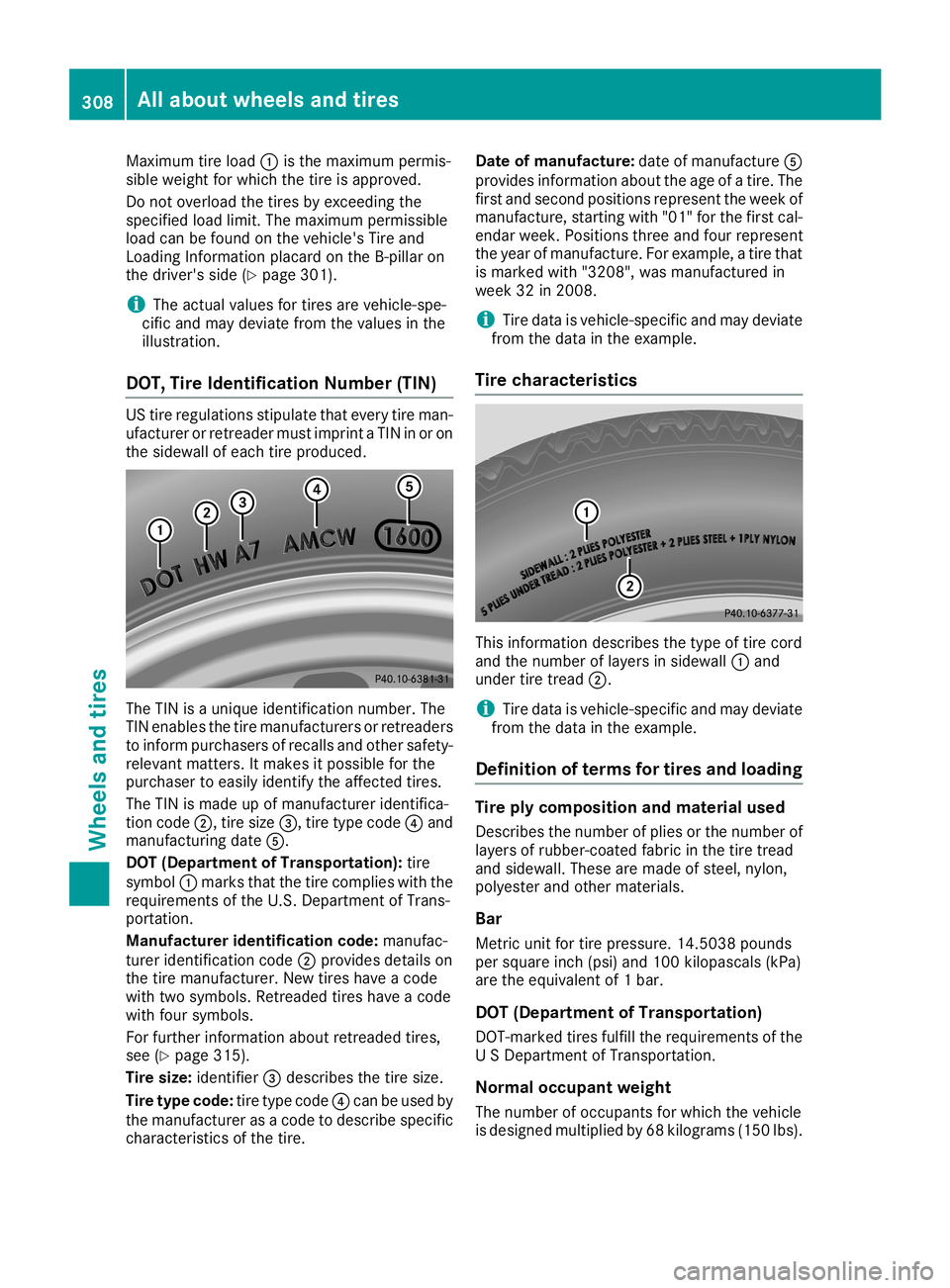
Maximum
tireload 0043isthe maximum permis-
sible weight forwhich thetire isapproved.
Do not overload thetires byexceeding the
specified loadlimit. Themaximum permissible
load canbefound onthe vehicle's Tireand
Loading Informationplacard onthe B-pillar on
the driver's side(Ypage 301).
i The
actual values fortires arevehicle-spe-
cific andmay deviate fromthevalues inthe
illu stration.
DOT, TireIdentification Number(TIN) US
tire regulations stipulatethatevery tireman-
ufacturer orretreader mustimprint aTIN inor on
the sidewa llof each tireproduced. The
TINisaunique identification number.The
TIN enables thetire manufacturers orretreaders
to inform purchasers ofrecalls andother safety-
relevant matters. Itmakes itpossible forthe
purchaser toeasily identify theaffected tires.
The TINismade upofmanufacturer identifica-
tion code 0044,tire size 0087,tire type code 0085and
manufacturing date0083.
DOT (Departm entofTra nsporta tion):tire
symbol 0043marks thatthetire complies withthe
requirements ofthe U.S. Departmen tof Trans-
portation.
Manufact ureridentification code:manufac-
turer identification code0044provides detailson
the tire manufacturer. Newtireshave acode
with twosymbols. Retreaded tireshave acode
with foursymbols.
For further information aboutretreaded tires,
see (Ypage 315).
Tire size: identifier 0087describes thetire size.
Tire type code: tiretype code 0085can beused by
the manufacturer asacode todescribe specific
characterist icsofthe tire. Date
ofmanufa cture:dateofmanufacture 0083
provides information abouttheage ofatire. The
first andsecond positions represent theweek of
manufacture, startingwith "01" forthe first cal-
endar week. Positions threeandfour represent
the year ofmanufacture. Forexample, atire that
is marked with"3208", wasmanufactured in
week 32in2008.
i Tire
data isvehicle-specific andmay deviate
from thedata inthe example.
Tire character istics This
information describesthetype oftire cord
and thenumber oflaye rsinsidewa ll0043 and
under tiretread 0044.
i Tire
data isvehicle-specific andmay deviate
from thedata inthe example.
Defini tionofterm sfor tires andloading Tire
plycomposition andmaterial used
Describes thenumber ofplies orthe number of
laye rsof rubber-coated fabricinthe tire tread
and sidewa ll.These aremade ofsteel, nylon,
polyester andother materials.
Bar
Metric unitfortire pressure. 14.5038pounds
per square inch(psi) and100 kilopascals (kPa)
are the equival entof1bar.
DOT (Departm entofTra nsporta tion)
DOT-m arkedtiresfulfill therequirements ofthe
U SDepartmen tof Transportation .
Norm aloccupant weight
The number ofoccupants forwhich thevehicle
is designed multiplied by68 kilograms (150lbs). 308
All
about wheelsand tiresWheels andtires